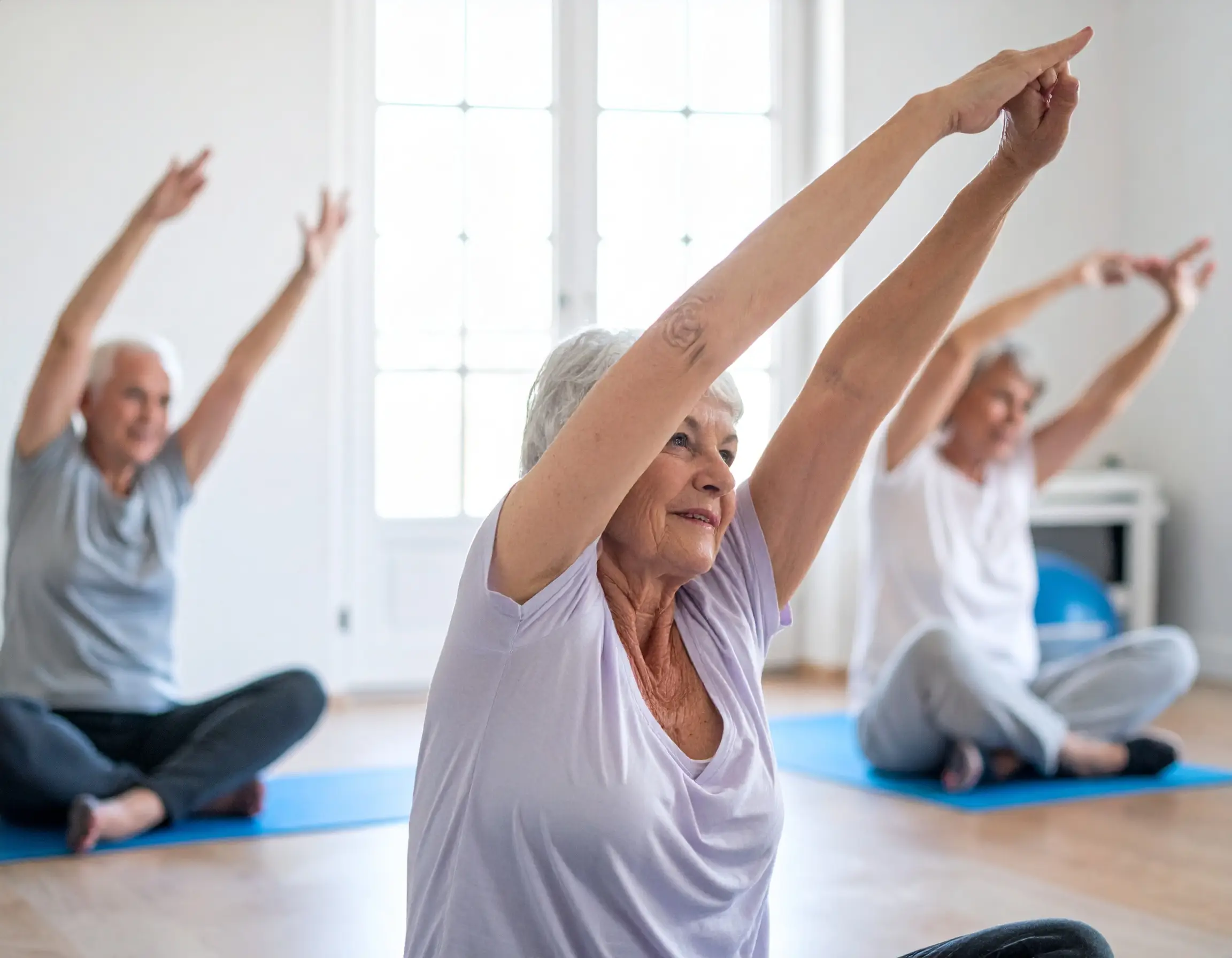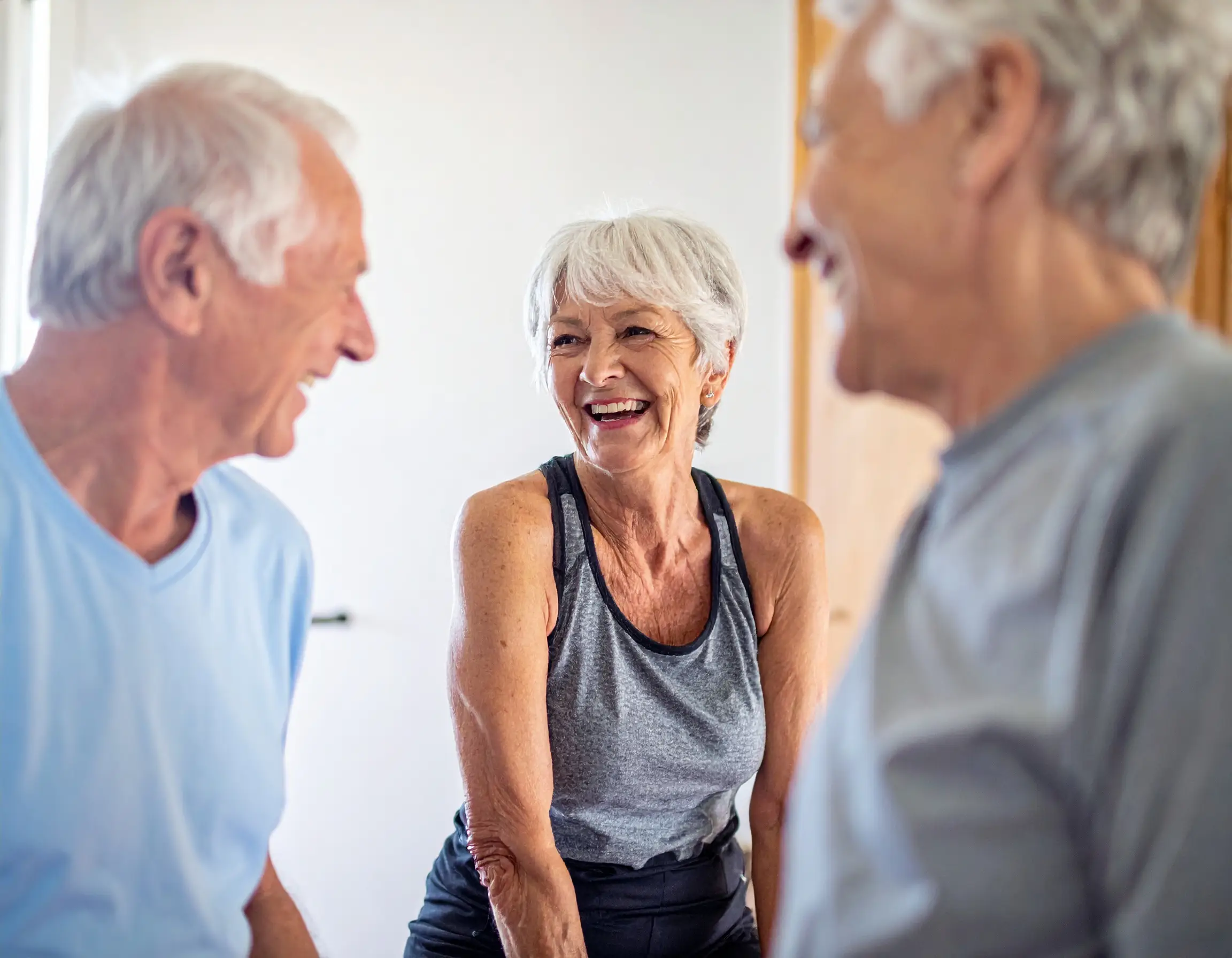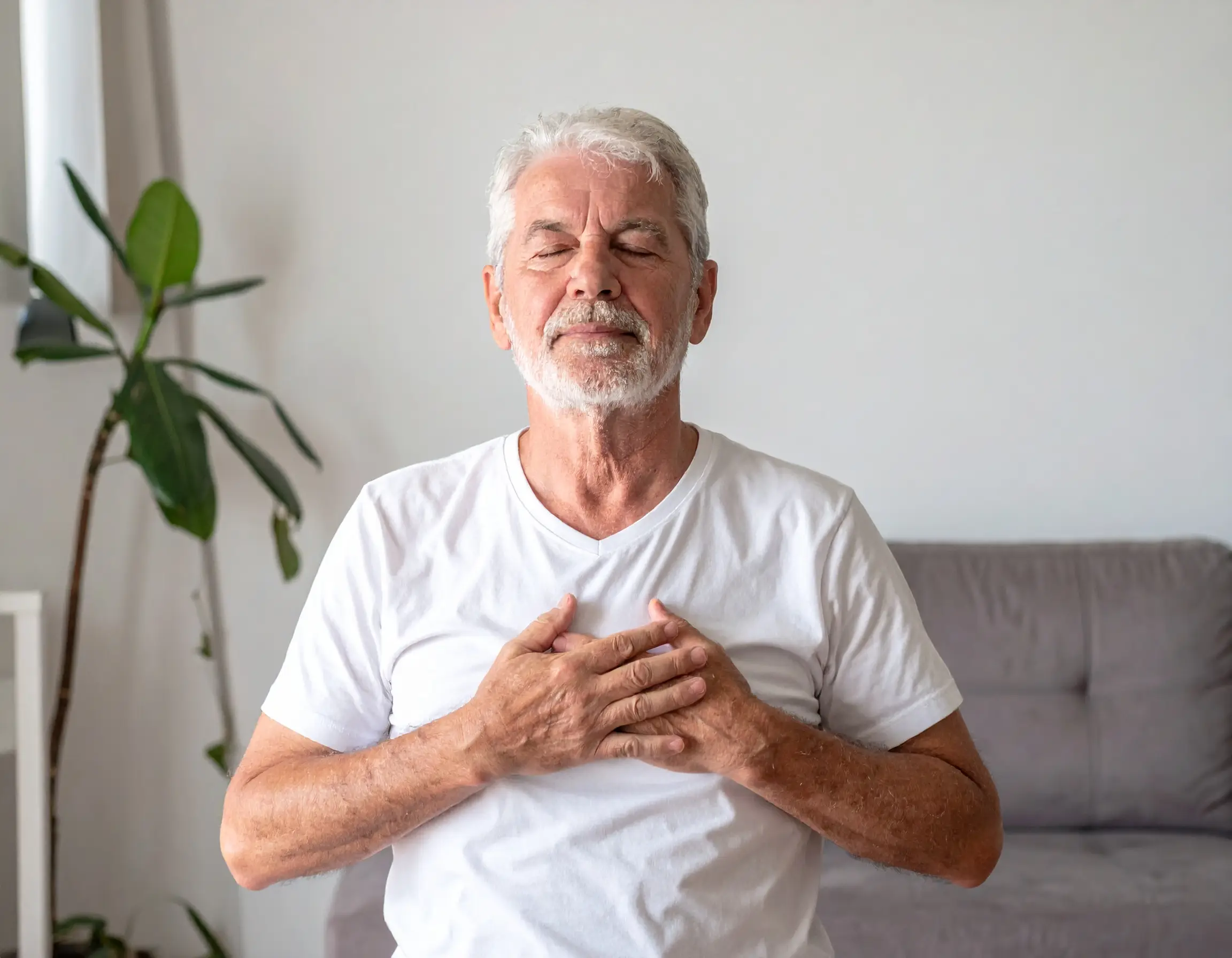How physiotherapy transforms your breathing
Physiotherapy for COPD is not simply about immediate relief. We concentrate on the long-term transformations that make every breath easier for those with COPD. We want to teach you to use your lungs optimally, so you can do more and feel less breathless.
Pulmonary rehab takes point here. It combines breath training, exercise, and education. We instruct different breathing techniques – such as pursed-lip, diaphragmatic, and paced breathing – to assist you in shifting air in and out of your lungs more effortlessly. These aren’t merely exercises – they’re tools you can deploy in daily life, particularly when you experience chest tightness or shortness of breath.
Research demonstrates that a six-month stint in these techniques can reduce breathlessness by 0.3 points and enhance patients’ sense of wellness. These improvements aren’t just statistics – they translate to you being able to walk longer distances, conquer stairs without pausing, or complete your work around the home.
| Technique | How it Works | Effectiveness for COPD |
|---|---|---|
| Pursed-lip Breathing | Slows breathing, keeps airways open longer | High – improves oxygen intake |
| Diaphragmatic Breathing | Strengthens diaphragm, reduces effort to breathe | Moderate – eases symptoms |
| Paced Breathing | Coordinates breath with movement | Moderate – boosts endurance |
Clearing your airways counts, as well. We educate on airway clearance, with things like huff coughing and postural drainage, that move mucus out of your lungs. This not only makes breathing easier, but reduces the threat of infections.
When your lungs are clearer, you can breathe more air in with every breath – which translates to less wheezing and coughing throughout the day.
Exercise is a big emphasis for us. We apply aerobic and resistance training individualized to what you are capable of, and then we help you to stretch a little further each time. This strengthens your muscles – not only your arms and legs – but the muscles you use to breathe.
As your exercise tolerance increases, normal daily activities such as walking to the store or carrying groceries become less of a chore. Your body’s more efficient at utilizing oxygen and you’re less fatigued. We’ve got the proof that following consistent physio, individuals with COPD experience improved lung volumes and an increase in vital capacity.
That is, your lungs are functioning more efficiently and you can do more before you need to hit pause and catch your breath.
Knowing how to control your symptoms empowers you. We help you identify early symptoms of potential trouble so you can take swift action and prevent setbacks. Our techniques are research-backed, but we understand what works for one person may not work for the next, so we always customize the plan.

The core physiotherapy techniques for COPD
We leverage lower body exercise, breathing techniques and structured rehab to help COPDers live better, breathe easier. Every strategy is rooted in real world experience and what works for the individuals we encounter on a daily basis.
Lower body exercises become a key focus of our care. When individuals engage in activities like treadmill walking and stair climbing, the heart and lungs become stronger. This allows them to manage day to day activities with less dyspnea.
For our patients, we begin with a training load that is logical for their current health, but it has to be just a little bit harder than what they experience during daily life. We understand muscle wasting and premature fatigue exacerbate the breathing difficulty in COPD. That’s why we pick exercises that hit those weak areas.
There’s no perfect “one size fits all” exercise, but here are some we use often:
- Treadmill walking – first gentle then brisk – as tolerated
- Stair climbing, taking just a few steps and increasing
- Stationary cycling, with resistance adjusted as strength grows
- Seated leg raises, good for those who need to start slow
- Sit-to-stand transitions from a sturdy chair
- Step-ups on a low platform, increasing the height over time
- Wall squats or partial squats with support for balance
We work on diaphragmatic breathing. That is, training individuals to use their abdominal muscles, not only their chest, to suck air in. Over time, this physiotherapy can strengthen the breathing muscles and enable them to absorb more air with less energy.
We teach our patients to do this at home, during workouts, and even when they become breathless.
Pulmonary rehabilitation (PR) puts all these pieces together. They have found that a 6 – 8 week program with lower body endurance and resistance training and self-management education produces the best results.
We collaborate with every individual to develop a plan that suits their requirements, be it interval training for those who fatigue easily, or a combination of endurance and resistance training. PR may be in a group or one-on-one, and we customize the plan as strength and stamina increases.
Let’s say some of our patients use bronchodilators like tiotropium. These drugs can help make breathing easier and allow patients to exercise at a higher intensity for extended periods.
We remember that the appropriate balance of endurance and resistance training is still being worked out, and we stay on top of new research to polish our approach.

Your personalized physiotherapy journey
Your journey for physiotherapy for Chronic obstructive pulmonary disease (COPD) would always start with a thorough evaluation. We determine what each individual needs the most assistance with, what their objectives are and the severity of their COPD. No, this isn’t just about lung function testing. We consider how someone moves, what makes breathing difficult, and how they are affected in day-to-day life.
We tend to default to the GOLD guidelines to assist us in determining the optimal starting point for care.
We believe in providing people with the knowledge to take control of their COPD. This is more than simply demonstrating breathing techniques. We educate in a variety of methods. Sometimes it’s a lecture, sometimes a handout, or even a book.
We discuss which breathing techniques are effective, the importance of exercise, managing stress, and the impact of nutrition and medicine. We ensure our patients understand the significance of these and how they can implement them at home. We frequently have family or caregivers in as well, so everyone is on the same page and can support the patient with COPD.
We understand that each journey is different. The time and number of physiotherapy visits varies significantly based on individual needs and objectives. Some thrive in one-on-one sessions, while others like groups for that added camaraderie.
We scale session frequency and intensity to the individual, not vice versa. For example, someone with mild COPD might come in once a week, while those with severe symptoms require more visits. Occasionally, group sessions blend in for camaraderie and peer education.
Goal setting is a huge component of our strategy. We assist in establishing mini-goals, such as walking a specific distance or employing a breathing method during household tasks. These targets help keep individuals motivated and make advancement simple to monitor.
As we proceed, we check in and find out how things are coming along. If symptoms change or something isn’t working, we adjust the plan. We monitor progress – how much a person can do, when they experience breathlessness, and even their mood.
Tracking and tuning the protocol is everything. Our steps for this are:
- Set clear, simple baseline measures for breathing and movement.
- Measure progress after every session – do easy tests such as walk distance in meters, or breathlessness rating.
- Hold regular reviews, where patient and physiotherapist discuss what’s better, what’s more difficult and what needs to be changed.
- Modify the plan if backsliding or new problems occur, such as a cold or flare-up.
- Introduce new treatments if necessary, like vaccines to prevent the flu or pneumonia.
- Keep family or caregivers in the loop, so support stays strong.
- Track progress with visible milestones, so enthusiasm remains ripe.
Achievement hinges on a number of factors – how much support an individual receives, how closely they adhere to the regimen, and the strength of their own drive. We want to establish confidence and empower individuals to take control of their health – not guarantee a miraculous outcome for everyone.

Physiotherapy’s impact on daily life
We understand how much COPD can restrict your life. With physiotherapy, we want people with COPD to feel less overwhelmed by their symptoms every day. By instructing basic breathing exercises and chest physiotherapy, we assist in mucus clearance to reduce infection risk and additional lung damage.
If you adhere to daily regimens, this advice can translate into less flare-ups and fewer hospital stays. Walking programs – particularly for post-hospitalized individuals, can rapidly restore strength and endurance. It’s satisfying to witness them begin with brief walks and then a few weeks later, cover longer distances effortlessly, illustrated by the six-minute walk test.
If you can walk further without breathlessness, your day-to-day activities such as shopping or seeing friends become much more accessible.
We coach people to control their symptoms at home by simplifying things into manageable steps. We assist you in becoming skilled at energy-conserving strategies for movement, day planning and pacing, so you don’t become fatigued or breathless.
We educate on how to purse-lip breathe and cough properly to clear mucus. These techniques are simple to acquire, and they keep you self-sufficient and less reliant on others for everyday necessities. Establishing these habits reduces the anxiety and depression that are common for individuals with COPD.
Many report that they feel more confident and less anxious once they’ve learned some specific methods to manage their breathing and activity.
Hospital readmission is a huge concern for a lot of people. We observe that patients who maintain their home exercises experience less readmissions in hospital. Resistance training, even in the context of a hospital stay, keeps muscles strong and enhances oxygen utilization, all without exacerbating inflammatory cascades.
We emphasize easy lifestyle modifications. Teaching about quitting smoking and eating well helps lungs and makes people feel powerful and energized. When you combine these elements – exercise, breathing work, and habit improvements – your quality of life can increase in significant, long-lasting ways.
Key home management strategies:
- Practice daily breathing exercises like pursed-lip breathing
- Use chest physiotherapy to clear mucus
- Set up a regular walking or gentle exercise plan
- Learn energy-saving ways to do tasks
- Plan rest breaks and avoid rushing through chores
- Follow advice on nutrition and hydration
- Work on quitting smoking if needed
- Track symptoms and know when to get help
The mind-body connection in COPD care
We witness in our work daily, that living with COPD isn’t just a matter of breathing troubles. It’s frequently about the mind-body connection. A lot of COPD patients experience stress, anxiety or even depression that can exacerbate symptoms and erode their daily lives. That’s why we value emotional wellness as much as physical care.
We commonly mix relaxation training and easy counseling into our physiotherapy blueprint. Breathing exercises, guided imagery and simple relaxation drills reduce stress and provide our patients with the means to settle their minds. When a person learns to relax his or her body, they often breathe easier and this can even help with lung function over time. We tailor these areas of care to the individual’s needs and comfort level.
A very important component of our philosophy is to promote socialization. COPD can be isolating. Many of us shy away from social functions or even family visits for fear of breathlessness or embarrassment. We attempt to shatter these walls with group classes, peer encouragement, or an easy check-in.
When patients tell their stories to others who are fighting the same battle, it usually boosts spirits and fosters self-belief. That sense of community reduces isolation and anxiety.
Studies show that mind-body exercises such as yoga and tai chi aid COPD. These mild moves, performed three or more times a week for a minimum of 12 weeks, can enhance lung power and assist with forced expiratory volume (FEV1). Others highlight improvements in forced vital capacity (FVC) as well, but the figures aren’t always robust.
What these exercises do best is assist individuals in managing stress and regulating anxiety – crucial for long-term health. We fare better with the 6-minute walk test as well. Individuals who remain with these programs can sometimes walk a greater distance and experience less fatigue.
Mindfulness and stress-reduction are a big part of our care as well. Even simple breathing drills, body scans and short meditation practices can help people manage the day-to-day mental load of COPD. Capnography-assisted therapy is another.
It’s more common in asthma care, and we occasionally use it when panic or extreme anxiety interferes with breathing. We know that not everyone desires or is able to join a group, so we customize these mind-body tools to each individual’s comfort level and objectives.
Here’s a table showing how different emotional well-being strategies link to patient outcomes:
| Emotional Strategy | Main Benefit | Patient Outcome |
|---|---|---|
| Relaxation training | Less anxiety | Improved breathing, mood |
| Social connection | Less isolation | Higher confidence, less stress |
| Mind-body exercise | Less stress | Better lung function (FEV1), more stamina |
| Mindfulness techniques | More calm | Better mood, easier symptom control |
Pulmonary rehab dropout is a serious issue, frequently caused by severe distress or depression. We always attempt to identify these early, and provide additional support, so more complete programs can be followed and patients receive the maximum benefit.

Finding the right physiotherapy support
It’s more than selecting a clinic near you – finding the right physio support for COPD. It’s about knowing what we require, and making sure the clinic aligns to that. We think that the right physiotherapy partner can help us breathe easier and move better, but it takes a bit of work to make the right choice.
We use a simple checklist to narrow down options: Does the clinic have therapists with real experience in COPD care? Do they provide group or individual sessions? Are they willing to work alongside our physician/care team? Do they have positive patient testimonials or experiences assisting others with comparable breathing issues?
We inquire about logistics as well, such as clinic hours, wait times and if they assist with insurance forms. Patient testimonials and outcomes count. We seek out clinics where previous patients discuss tangible differences – walking further, experiencing reduced breathlessness, or simply feeling stronger in everyday life.
Find the right physiotherapy support – A six-month physio program can really make a difference for COPD. Most experience large improvements in walking distance and function in everyday activity. We want to evidence that the clinic’s technique is effective, not just hype.
Initial consultations are critical. We always recommend scheduling an initial appointment to discuss our requirements and what COPD management entails. A quality physio will take the time to question, examine our lifestyle and check our inhalation and movement.
They’ll discuss the possibilities, like what exercises could work for us, and how frequently we might need to come in. We desire a plan that’s designed for us, not a cookie-cutter, one size fits all exercise.
Outpatient programs with group exercise can assist as well. We discovered that group training provided us with more than muscle – it gave us community. Exercising alongside others who understand what we’re going through can make us challenge ourselves harder, and keep at it for a longer period.
It’s usually more affordable than private sessions! These programs typically involve exercise, breath training and self-management of symptoms.
To be cared for by someone who knows COPD inside out. The good clinics provide pulmonary rehab, with exercise and education and self-care training. They assist us in developing our resilience, instruct us in breathing techniques, and educate us on how to identify and control exacerbations.
We seek out clinics with therapists who are accredited, stay abreast of new research, and actually hear our concerns.


